Conflict Resolution and Negotiation Strategies
VerifiedAdded on 2020/02/05
|13
|3796
|115
Essay
AI Summary
This assignment delves into the complexities of conflict resolution and negotiation within organizations. It examines various conflict management styles, negotiation principles, and practical strategies for achieving mutually beneficial outcomes. Students are expected to analyze different scenarios, apply relevant theories, and propose effective solutions for resolving conflicts constructively.
Contribute Materials
Your contribution can guide someone’s learning journey. Share your
documents today.
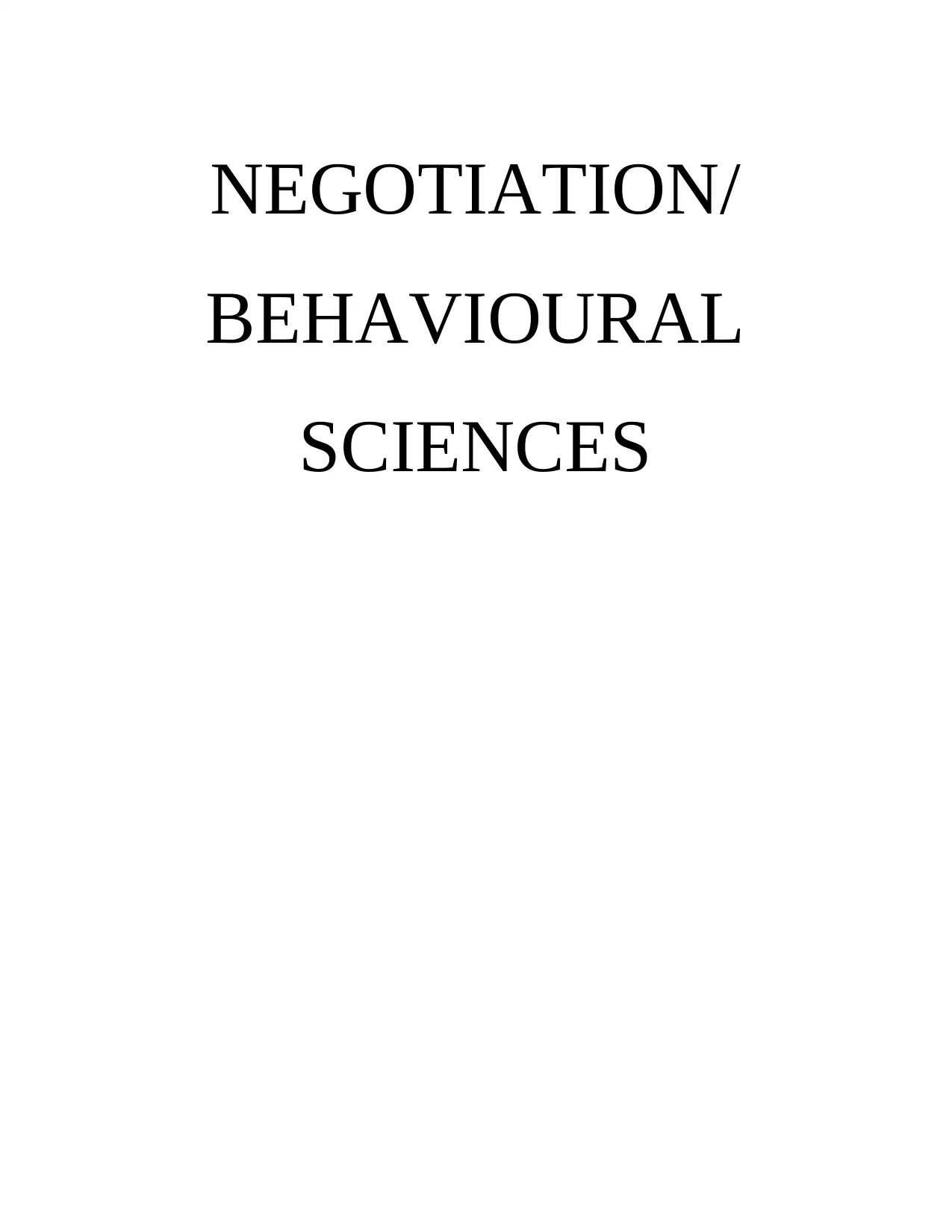
NEGOTIATION/
BEHAVIOURAL
SCIENCES
BEHAVIOURAL
SCIENCES
Secure Best Marks with AI Grader
Need help grading? Try our AI Grader for instant feedback on your assignments.
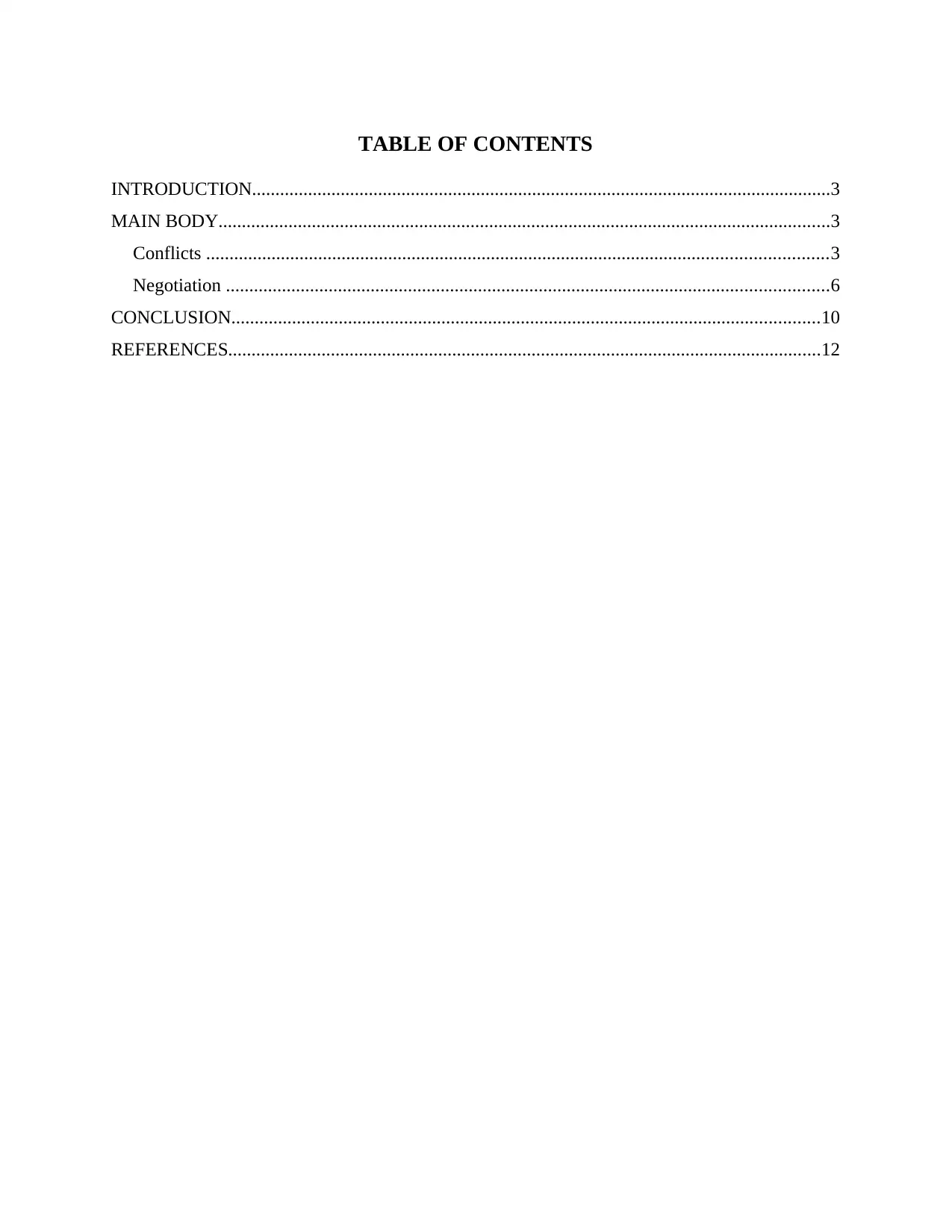
TABLE OF CONTENTS
INTRODUCTION............................................................................................................................3
MAIN BODY...................................................................................................................................3
Conflicts .....................................................................................................................................3
Negotiation .................................................................................................................................6
CONCLUSION..............................................................................................................................10
REFERENCES...............................................................................................................................12
INTRODUCTION............................................................................................................................3
MAIN BODY...................................................................................................................................3
Conflicts .....................................................................................................................................3
Negotiation .................................................................................................................................6
CONCLUSION..............................................................................................................................10
REFERENCES...............................................................................................................................12
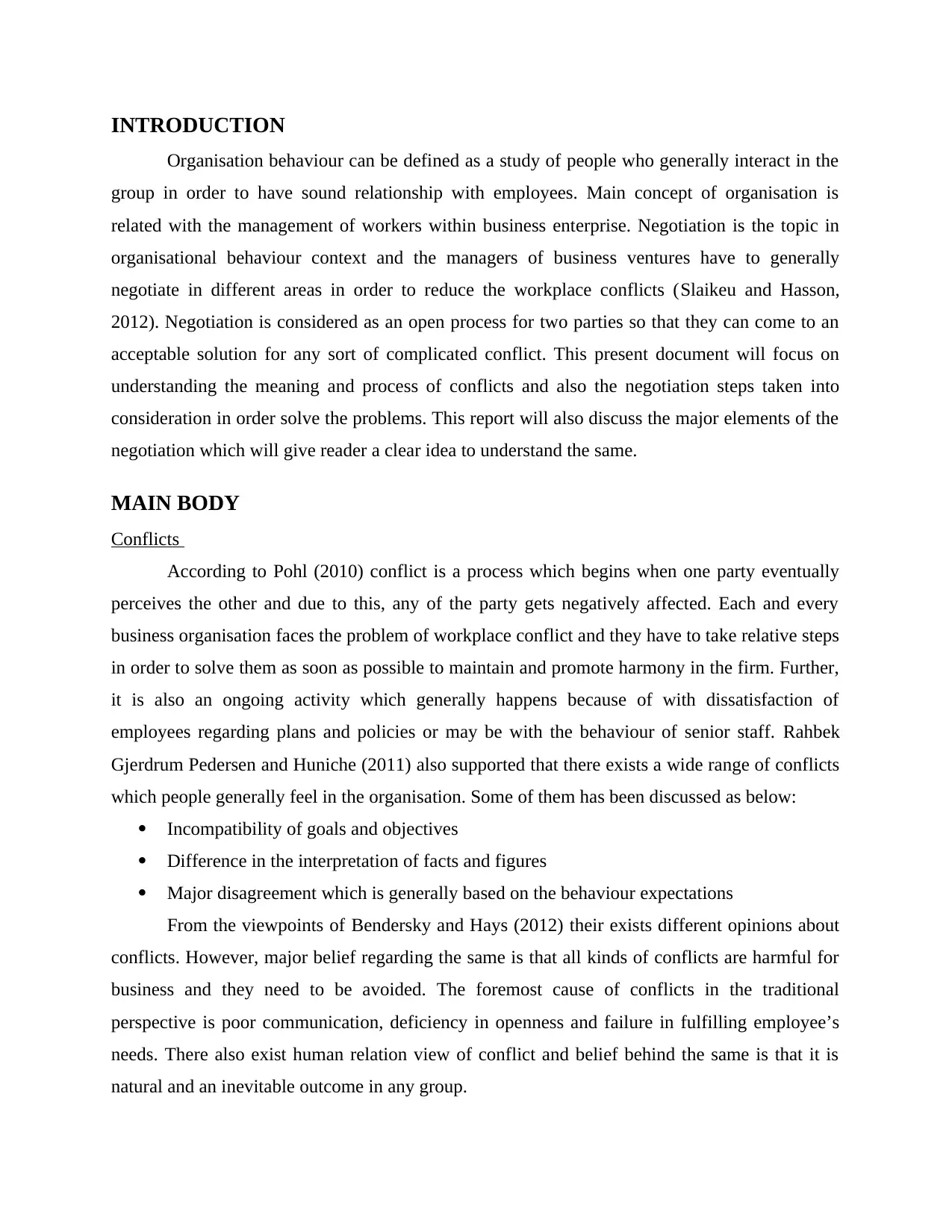
INTRODUCTION
Organisation behaviour can be defined as a study of people who generally interact in the
group in order to have sound relationship with employees. Main concept of organisation is
related with the management of workers within business enterprise. Negotiation is the topic in
organisational behaviour context and the managers of business ventures have to generally
negotiate in different areas in order to reduce the workplace conflicts (Slaikeu and Hasson,
2012). Negotiation is considered as an open process for two parties so that they can come to an
acceptable solution for any sort of complicated conflict. This present document will focus on
understanding the meaning and process of conflicts and also the negotiation steps taken into
consideration in order solve the problems. This report will also discuss the major elements of the
negotiation which will give reader a clear idea to understand the same.
MAIN BODY
Conflicts
According to Pohl (2010) conflict is a process which begins when one party eventually
perceives the other and due to this, any of the party gets negatively affected. Each and every
business organisation faces the problem of workplace conflict and they have to take relative steps
in order to solve them as soon as possible to maintain and promote harmony in the firm. Further,
it is also an ongoing activity which generally happens because of with dissatisfaction of
employees regarding plans and policies or may be with the behaviour of senior staff. Rahbek
Gjerdrum Pedersen and Huniche (2011) also supported that there exists a wide range of conflicts
which people generally feel in the organisation. Some of them has been discussed as below:
Incompatibility of goals and objectives
Difference in the interpretation of facts and figures
Major disagreement which is generally based on the behaviour expectations
From the viewpoints of Bendersky and Hays (2012) their exists different opinions about
conflicts. However, major belief regarding the same is that all kinds of conflicts are harmful for
business and they need to be avoided. The foremost cause of conflicts in the traditional
perspective is poor communication, deficiency in openness and failure in fulfilling employee’s
needs. There also exist human relation view of conflict and belief behind the same is that it is
natural and an inevitable outcome in any group.
Organisation behaviour can be defined as a study of people who generally interact in the
group in order to have sound relationship with employees. Main concept of organisation is
related with the management of workers within business enterprise. Negotiation is the topic in
organisational behaviour context and the managers of business ventures have to generally
negotiate in different areas in order to reduce the workplace conflicts (Slaikeu and Hasson,
2012). Negotiation is considered as an open process for two parties so that they can come to an
acceptable solution for any sort of complicated conflict. This present document will focus on
understanding the meaning and process of conflicts and also the negotiation steps taken into
consideration in order solve the problems. This report will also discuss the major elements of the
negotiation which will give reader a clear idea to understand the same.
MAIN BODY
Conflicts
According to Pohl (2010) conflict is a process which begins when one party eventually
perceives the other and due to this, any of the party gets negatively affected. Each and every
business organisation faces the problem of workplace conflict and they have to take relative steps
in order to solve them as soon as possible to maintain and promote harmony in the firm. Further,
it is also an ongoing activity which generally happens because of with dissatisfaction of
employees regarding plans and policies or may be with the behaviour of senior staff. Rahbek
Gjerdrum Pedersen and Huniche (2011) also supported that there exists a wide range of conflicts
which people generally feel in the organisation. Some of them has been discussed as below:
Incompatibility of goals and objectives
Difference in the interpretation of facts and figures
Major disagreement which is generally based on the behaviour expectations
From the viewpoints of Bendersky and Hays (2012) their exists different opinions about
conflicts. However, major belief regarding the same is that all kinds of conflicts are harmful for
business and they need to be avoided. The foremost cause of conflicts in the traditional
perspective is poor communication, deficiency in openness and failure in fulfilling employee’s
needs. There also exist human relation view of conflict and belief behind the same is that it is
natural and an inevitable outcome in any group.
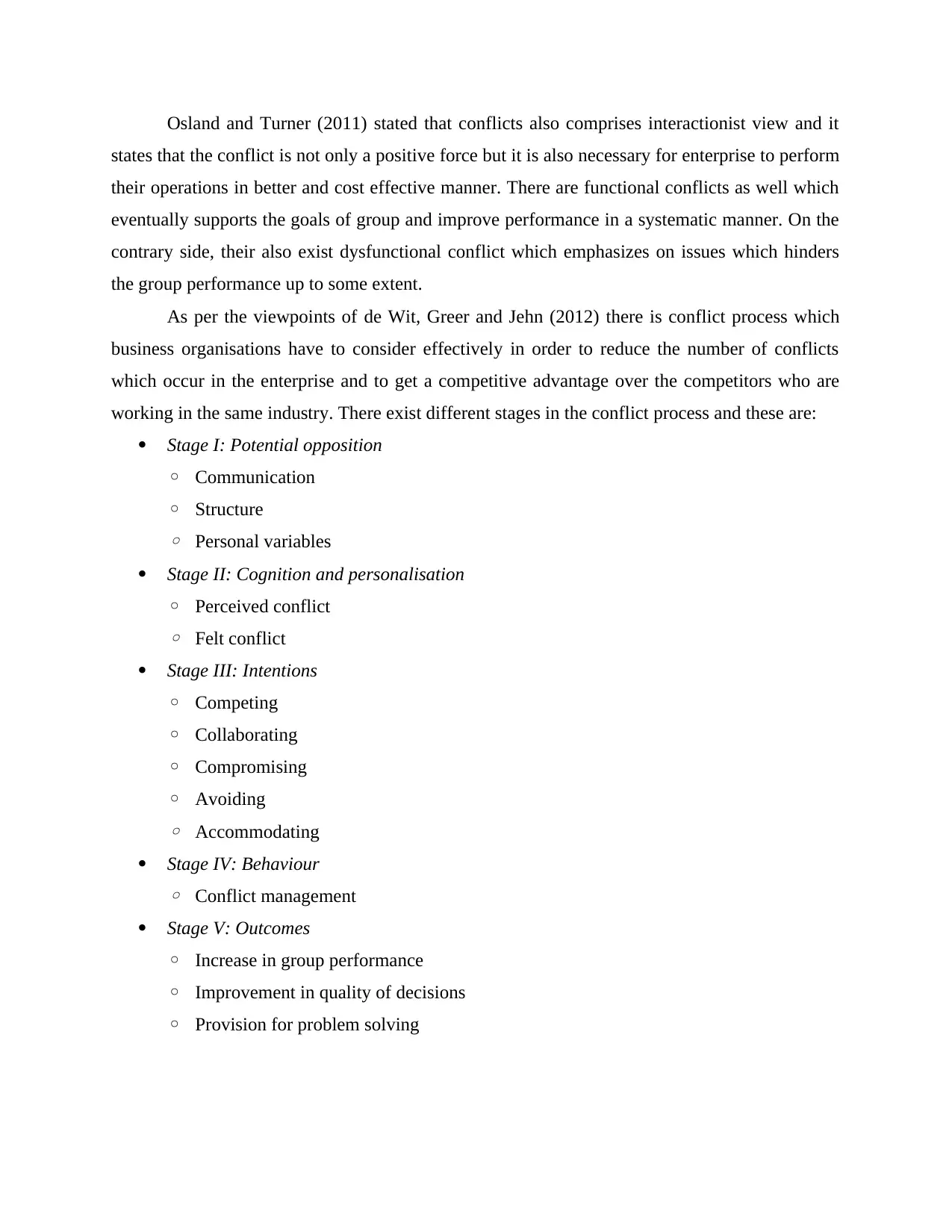
Osland and Turner (2011) stated that conflicts also comprises interactionist view and it
states that the conflict is not only a positive force but it is also necessary for enterprise to perform
their operations in better and cost effective manner. There are functional conflicts as well which
eventually supports the goals of group and improve performance in a systematic manner. On the
contrary side, their also exist dysfunctional conflict which emphasizes on issues which hinders
the group performance up to some extent.
As per the viewpoints of de Wit, Greer and Jehn (2012) there is conflict process which
business organisations have to consider effectively in order to reduce the number of conflicts
which occur in the enterprise and to get a competitive advantage over the competitors who are
working in the same industry. There exist different stages in the conflict process and these are:
Stage I: Potential opposition
◦ Communication
◦ Structure
◦ Personal variables
Stage II: Cognition and personalisation
◦ Perceived conflict
◦ Felt conflict
Stage III: Intentions
◦ Competing
◦ Collaborating
◦ Compromising
◦ Avoiding
◦ Accommodating
Stage IV: Behaviour
◦ Conflict management
Stage V: Outcomes
◦ Increase in group performance
◦ Improvement in quality of decisions
◦ Provision for problem solving
states that the conflict is not only a positive force but it is also necessary for enterprise to perform
their operations in better and cost effective manner. There are functional conflicts as well which
eventually supports the goals of group and improve performance in a systematic manner. On the
contrary side, their also exist dysfunctional conflict which emphasizes on issues which hinders
the group performance up to some extent.
As per the viewpoints of de Wit, Greer and Jehn (2012) there is conflict process which
business organisations have to consider effectively in order to reduce the number of conflicts
which occur in the enterprise and to get a competitive advantage over the competitors who are
working in the same industry. There exist different stages in the conflict process and these are:
Stage I: Potential opposition
◦ Communication
◦ Structure
◦ Personal variables
Stage II: Cognition and personalisation
◦ Perceived conflict
◦ Felt conflict
Stage III: Intentions
◦ Competing
◦ Collaborating
◦ Compromising
◦ Avoiding
◦ Accommodating
Stage IV: Behaviour
◦ Conflict management
Stage V: Outcomes
◦ Increase in group performance
◦ Improvement in quality of decisions
◦ Provision for problem solving
Secure Best Marks with AI Grader
Need help grading? Try our AI Grader for instant feedback on your assignments.
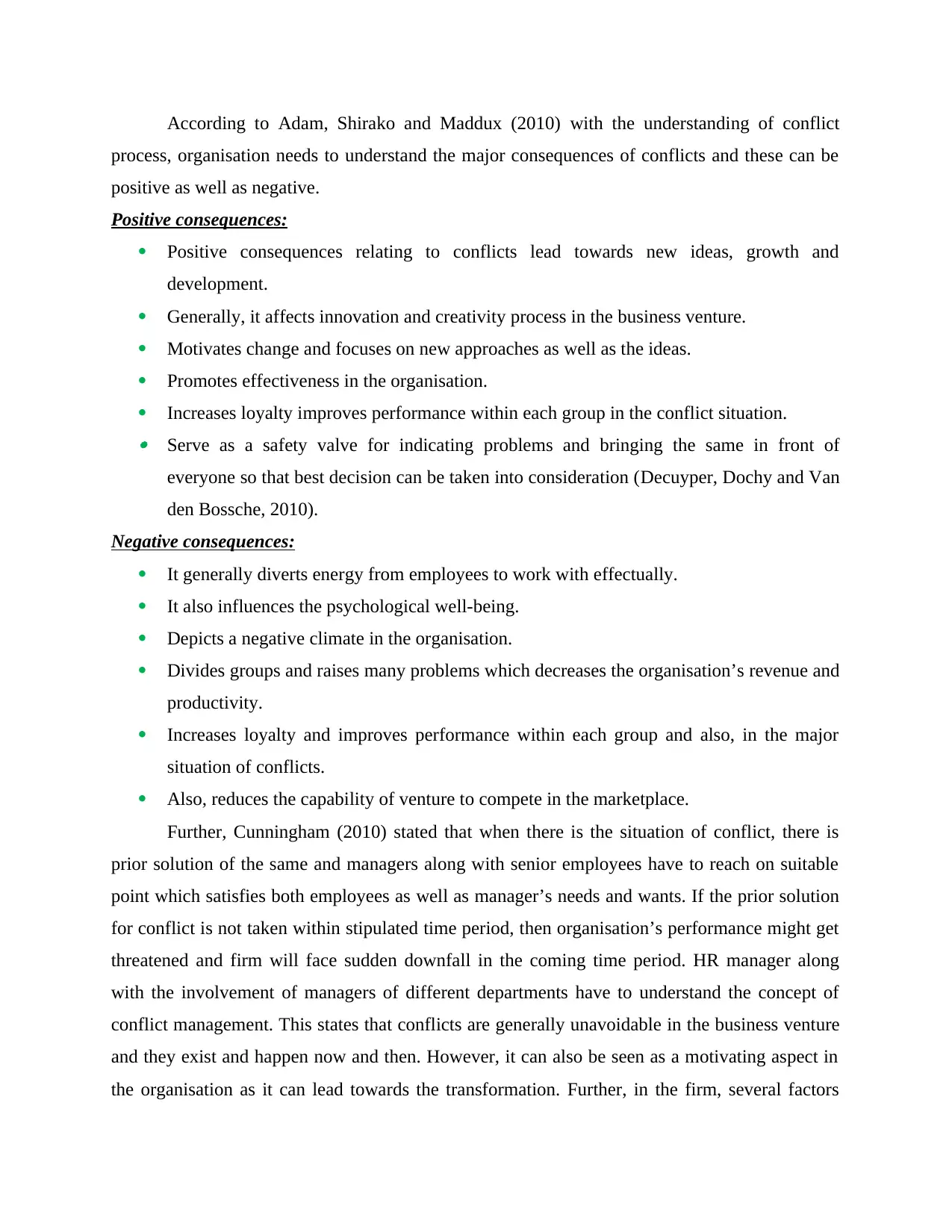
According to Adam, Shirako and Maddux (2010) with the understanding of conflict
process, organisation needs to understand the major consequences of conflicts and these can be
positive as well as negative.
Positive consequences:
Positive consequences relating to conflicts lead towards new ideas, growth and
development.
Generally, it affects innovation and creativity process in the business venture.
Motivates change and focuses on new approaches as well as the ideas.
Promotes effectiveness in the organisation.
Increases loyalty improves performance within each group in the conflict situation. Serve as a safety valve for indicating problems and bringing the same in front of
everyone so that best decision can be taken into consideration (Decuyper, Dochy and Van
den Bossche, 2010).
Negative consequences:
It generally diverts energy from employees to work with effectually.
It also influences the psychological well-being.
Depicts a negative climate in the organisation.
Divides groups and raises many problems which decreases the organisation’s revenue and
productivity.
Increases loyalty and improves performance within each group and also, in the major
situation of conflicts.
Also, reduces the capability of venture to compete in the marketplace.
Further, Cunningham (2010) stated that when there is the situation of conflict, there is
prior solution of the same and managers along with senior employees have to reach on suitable
point which satisfies both employees as well as manager’s needs and wants. If the prior solution
for conflict is not taken within stipulated time period, then organisation’s performance might get
threatened and firm will face sudden downfall in the coming time period. HR manager along
with the involvement of managers of different departments have to understand the concept of
conflict management. This states that conflicts are generally unavoidable in the business venture
and they exist and happen now and then. However, it can also be seen as a motivating aspect in
the organisation as it can lead towards the transformation. Further, in the firm, several factors
process, organisation needs to understand the major consequences of conflicts and these can be
positive as well as negative.
Positive consequences:
Positive consequences relating to conflicts lead towards new ideas, growth and
development.
Generally, it affects innovation and creativity process in the business venture.
Motivates change and focuses on new approaches as well as the ideas.
Promotes effectiveness in the organisation.
Increases loyalty improves performance within each group in the conflict situation. Serve as a safety valve for indicating problems and bringing the same in front of
everyone so that best decision can be taken into consideration (Decuyper, Dochy and Van
den Bossche, 2010).
Negative consequences:
It generally diverts energy from employees to work with effectually.
It also influences the psychological well-being.
Depicts a negative climate in the organisation.
Divides groups and raises many problems which decreases the organisation’s revenue and
productivity.
Increases loyalty and improves performance within each group and also, in the major
situation of conflicts.
Also, reduces the capability of venture to compete in the marketplace.
Further, Cunningham (2010) stated that when there is the situation of conflict, there is
prior solution of the same and managers along with senior employees have to reach on suitable
point which satisfies both employees as well as manager’s needs and wants. If the prior solution
for conflict is not taken within stipulated time period, then organisation’s performance might get
threatened and firm will face sudden downfall in the coming time period. HR manager along
with the involvement of managers of different departments have to understand the concept of
conflict management. This states that conflicts are generally unavoidable in the business venture
and they exist and happen now and then. However, it can also be seen as a motivating aspect in
the organisation as it can lead towards the transformation. Further, in the firm, several factors
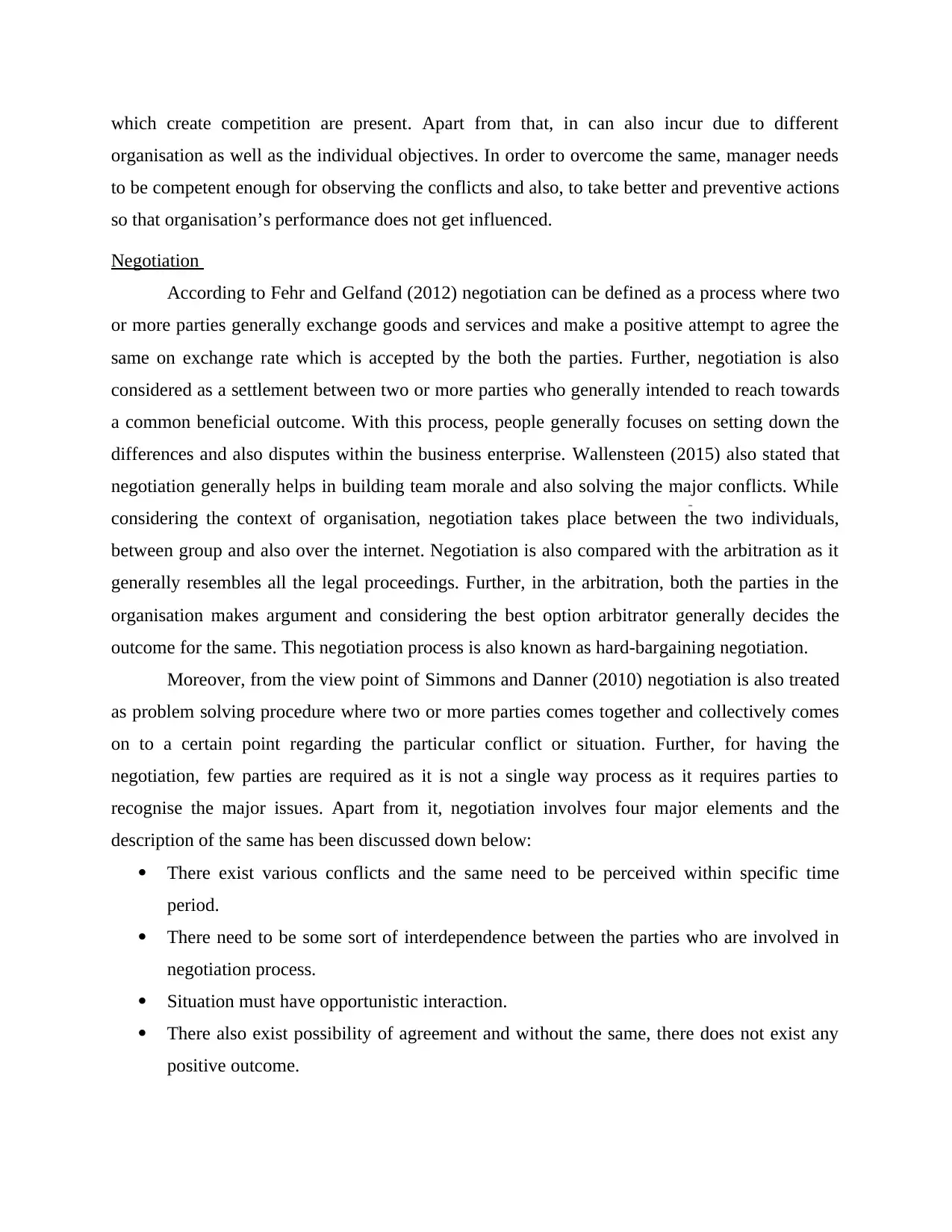
which create competition are present. Apart from that, in can also incur due to different
organisation as well as the individual objectives. In order to overcome the same, manager needs
to be competent enough for observing the conflicts and also, to take better and preventive actions
so that organisation’s performance does not get influenced.
Negotiation
According to Fehr and Gelfand (2012) negotiation can be defined as a process where two
or more parties generally exchange goods and services and make a positive attempt to agree the
same on exchange rate which is accepted by the both the parties. Further, negotiation is also
considered as a settlement between two or more parties who generally intended to reach towards
a common beneficial outcome. With this process, people generally focuses on setting down the
differences and also disputes within the business enterprise. Wallensteen (2015) also stated that
negotiation generally helps in building team morale and also solving the major conflicts. While
considering the context of organisation, negotiation takes place between the two individuals,
between group and also over the internet. Negotiation is also compared with the arbitration as it
generally resembles all the legal proceedings. Further, in the arbitration, both the parties in the
organisation makes argument and considering the best option arbitrator generally decides the
outcome for the same. This negotiation process is also known as hard-bargaining negotiation.
Moreover, from the view point of Simmons and Danner (2010) negotiation is also treated
as problem solving procedure where two or more parties comes together and collectively comes
on to a certain point regarding the particular conflict or situation. Further, for having the
negotiation, few parties are required as it is not a single way process as it requires parties to
recognise the major issues. Apart from it, negotiation involves four major elements and the
description of the same has been discussed down below:
There exist various conflicts and the same need to be perceived within specific time
period.
There need to be some sort of interdependence between the parties who are involved in
negotiation process.
Situation must have opportunistic interaction.
There also exist possibility of agreement and without the same, there does not exist any
positive outcome.
organisation as well as the individual objectives. In order to overcome the same, manager needs
to be competent enough for observing the conflicts and also, to take better and preventive actions
so that organisation’s performance does not get influenced.
Negotiation
According to Fehr and Gelfand (2012) negotiation can be defined as a process where two
or more parties generally exchange goods and services and make a positive attempt to agree the
same on exchange rate which is accepted by the both the parties. Further, negotiation is also
considered as a settlement between two or more parties who generally intended to reach towards
a common beneficial outcome. With this process, people generally focuses on setting down the
differences and also disputes within the business enterprise. Wallensteen (2015) also stated that
negotiation generally helps in building team morale and also solving the major conflicts. While
considering the context of organisation, negotiation takes place between the two individuals,
between group and also over the internet. Negotiation is also compared with the arbitration as it
generally resembles all the legal proceedings. Further, in the arbitration, both the parties in the
organisation makes argument and considering the best option arbitrator generally decides the
outcome for the same. This negotiation process is also known as hard-bargaining negotiation.
Moreover, from the view point of Simmons and Danner (2010) negotiation is also treated
as problem solving procedure where two or more parties comes together and collectively comes
on to a certain point regarding the particular conflict or situation. Further, for having the
negotiation, few parties are required as it is not a single way process as it requires parties to
recognise the major issues. Apart from it, negotiation involves four major elements and the
description of the same has been discussed down below:
There exist various conflicts and the same need to be perceived within specific time
period.
There need to be some sort of interdependence between the parties who are involved in
negotiation process.
Situation must have opportunistic interaction.
There also exist possibility of agreement and without the same, there does not exist any
positive outcome.
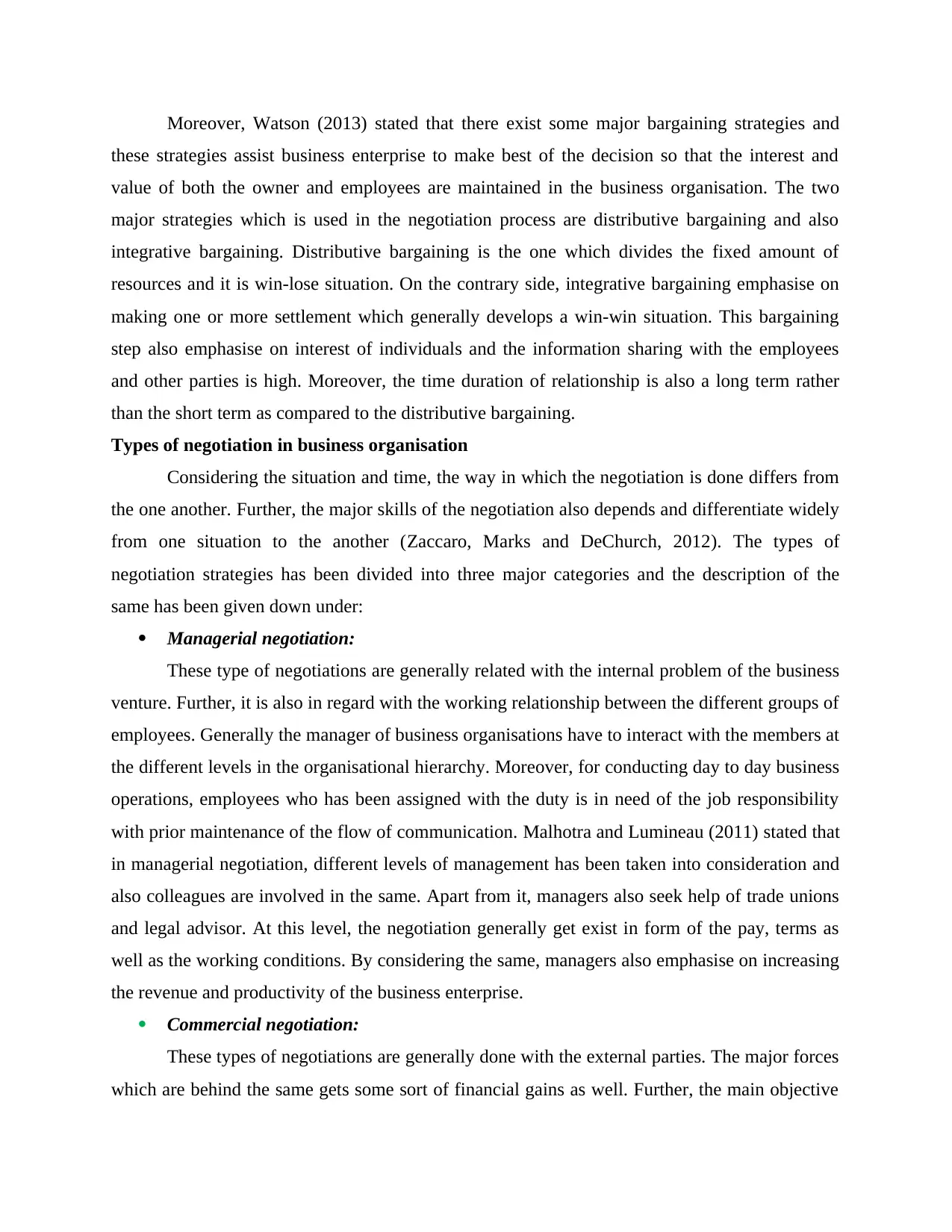
Moreover, Watson (2013) stated that there exist some major bargaining strategies and
these strategies assist business enterprise to make best of the decision so that the interest and
value of both the owner and employees are maintained in the business organisation. The two
major strategies which is used in the negotiation process are distributive bargaining and also
integrative bargaining. Distributive bargaining is the one which divides the fixed amount of
resources and it is win-lose situation. On the contrary side, integrative bargaining emphasise on
making one or more settlement which generally develops a win-win situation. This bargaining
step also emphasise on interest of individuals and the information sharing with the employees
and other parties is high. Moreover, the time duration of relationship is also a long term rather
than the short term as compared to the distributive bargaining.
Types of negotiation in business organisation
Considering the situation and time, the way in which the negotiation is done differs from
the one another. Further, the major skills of the negotiation also depends and differentiate widely
from one situation to the another (Zaccaro, Marks and DeChurch, 2012). The types of
negotiation strategies has been divided into three major categories and the description of the
same has been given down under:
Managerial negotiation:
These type of negotiations are generally related with the internal problem of the business
venture. Further, it is also in regard with the working relationship between the different groups of
employees. Generally the manager of business organisations have to interact with the members at
the different levels in the organisational hierarchy. Moreover, for conducting day to day business
operations, employees who has been assigned with the duty is in need of the job responsibility
with prior maintenance of the flow of communication. Malhotra and Lumineau (2011) stated that
in managerial negotiation, different levels of management has been taken into consideration and
also colleagues are involved in the same. Apart from it, managers also seek help of trade unions
and legal advisor. At this level, the negotiation generally get exist in form of the pay, terms as
well as the working conditions. By considering the same, managers also emphasise on increasing
the revenue and productivity of the business enterprise.
Commercial negotiation:
These types of negotiations are generally done with the external parties. The major forces
which are behind the same gets some sort of financial gains as well. Further, the main objective
these strategies assist business enterprise to make best of the decision so that the interest and
value of both the owner and employees are maintained in the business organisation. The two
major strategies which is used in the negotiation process are distributive bargaining and also
integrative bargaining. Distributive bargaining is the one which divides the fixed amount of
resources and it is win-lose situation. On the contrary side, integrative bargaining emphasise on
making one or more settlement which generally develops a win-win situation. This bargaining
step also emphasise on interest of individuals and the information sharing with the employees
and other parties is high. Moreover, the time duration of relationship is also a long term rather
than the short term as compared to the distributive bargaining.
Types of negotiation in business organisation
Considering the situation and time, the way in which the negotiation is done differs from
the one another. Further, the major skills of the negotiation also depends and differentiate widely
from one situation to the another (Zaccaro, Marks and DeChurch, 2012). The types of
negotiation strategies has been divided into three major categories and the description of the
same has been given down under:
Managerial negotiation:
These type of negotiations are generally related with the internal problem of the business
venture. Further, it is also in regard with the working relationship between the different groups of
employees. Generally the manager of business organisations have to interact with the members at
the different levels in the organisational hierarchy. Moreover, for conducting day to day business
operations, employees who has been assigned with the duty is in need of the job responsibility
with prior maintenance of the flow of communication. Malhotra and Lumineau (2011) stated that
in managerial negotiation, different levels of management has been taken into consideration and
also colleagues are involved in the same. Apart from it, managers also seek help of trade unions
and legal advisor. At this level, the negotiation generally get exist in form of the pay, terms as
well as the working conditions. By considering the same, managers also emphasise on increasing
the revenue and productivity of the business enterprise.
Commercial negotiation:
These types of negotiations are generally done with the external parties. The major forces
which are behind the same gets some sort of financial gains as well. Further, the main objective
Paraphrase This Document
Need a fresh take? Get an instant paraphrase of this document with our AI Paraphraser

of this relationship is based on the concept of give and take. Further, these commercial
negotiations generally gets up wind up in terms of contracts. One resource is generally get
sacrificed in order to obtain the other. Further, from the view point of the Touraine (2015) parties
which are involved in such negotiation includes management, customers, government, suppliers,
trade unions, legal advisor and public. Customers majorly negotiate the price in order to get the
same at an affordable price. However, a mutual decisions is been taken by the manager so that
the interest of the both does not get influence and with this both the parties are able to achieve
their goals and objectives in significant manner.
Legal negotiation:
These types of negotiation are generally considered as formal and comprises the legal
binding. Disputes are generally considered as the major issues and major steps are taken into
consideration in order to solve the same within the specific time period. Further, these are also
contractual in nature and need some sort of the legal grounds as well. Abolafia (2010) stated that
the parties involved for the same are the government, management and the customers. Business
organisation has to follow all the plans and policies which are formed by the local government
and have to take the decisions accordingly. Further, managers are required to bound with all the
legal proceedings and make their organisation policies accordingly.
Moreover, business organisations also rely on the concept of BATNA which stood for
Best Alternative To A Negotiated Agreement. This is the lowest acceptable value for an
individual towards the negotiated agreement.
Major issues in negotiation
There exist various issues in negotiation and the manager of business organisation has to
consider the same in order to have prior and systematic functioning. Some of the issues has been
discussed down under:
Role of personality trait in organisation:
Personality traits in employees generally differ from one individual to the another and the
same has direct effect on the outcome of bargaining as well as the negotiation process within the
venture (Brown, 2010).
Existence of Gender difference in organisation:
According to Zeitoun, Mirumachi and Warner (2011) participation of employees in the
working has been significantly increased and women to negotiate no differently from men.
negotiations generally gets up wind up in terms of contracts. One resource is generally get
sacrificed in order to obtain the other. Further, from the view point of the Touraine (2015) parties
which are involved in such negotiation includes management, customers, government, suppliers,
trade unions, legal advisor and public. Customers majorly negotiate the price in order to get the
same at an affordable price. However, a mutual decisions is been taken by the manager so that
the interest of the both does not get influence and with this both the parties are able to achieve
their goals and objectives in significant manner.
Legal negotiation:
These types of negotiation are generally considered as formal and comprises the legal
binding. Disputes are generally considered as the major issues and major steps are taken into
consideration in order to solve the same within the specific time period. Further, these are also
contractual in nature and need some sort of the legal grounds as well. Abolafia (2010) stated that
the parties involved for the same are the government, management and the customers. Business
organisation has to follow all the plans and policies which are formed by the local government
and have to take the decisions accordingly. Further, managers are required to bound with all the
legal proceedings and make their organisation policies accordingly.
Moreover, business organisations also rely on the concept of BATNA which stood for
Best Alternative To A Negotiated Agreement. This is the lowest acceptable value for an
individual towards the negotiated agreement.
Major issues in negotiation
There exist various issues in negotiation and the manager of business organisation has to
consider the same in order to have prior and systematic functioning. Some of the issues has been
discussed down under:
Role of personality trait in organisation:
Personality traits in employees generally differ from one individual to the another and the
same has direct effect on the outcome of bargaining as well as the negotiation process within the
venture (Brown, 2010).
Existence of Gender difference in organisation:
According to Zeitoun, Mirumachi and Warner (2011) participation of employees in the
working has been significantly increased and women to negotiate no differently from men.
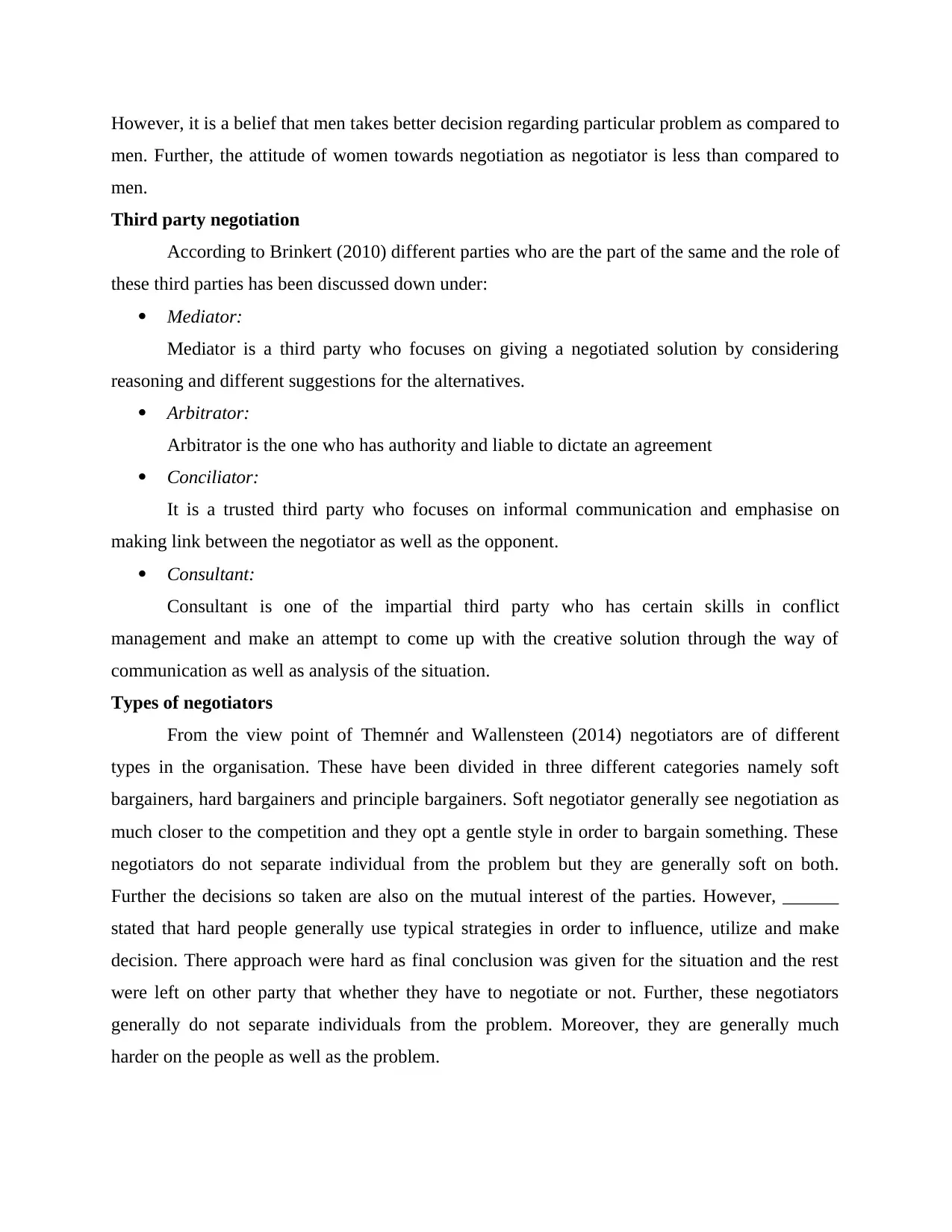
However, it is a belief that men takes better decision regarding particular problem as compared to
men. Further, the attitude of women towards negotiation as negotiator is less than compared to
men.
Third party negotiation
According to Brinkert (2010) different parties who are the part of the same and the role of
these third parties has been discussed down under:
Mediator:
Mediator is a third party who focuses on giving a negotiated solution by considering
reasoning and different suggestions for the alternatives.
Arbitrator:
Arbitrator is the one who has authority and liable to dictate an agreement
Conciliator:
It is a trusted third party who focuses on informal communication and emphasise on
making link between the negotiator as well as the opponent.
Consultant:
Consultant is one of the impartial third party who has certain skills in conflict
management and make an attempt to come up with the creative solution through the way of
communication as well as analysis of the situation.
Types of negotiators
From the view point of Themnér and Wallensteen (2014) negotiators are of different
types in the organisation. These have been divided in three different categories namely soft
bargainers, hard bargainers and principle bargainers. Soft negotiator generally see negotiation as
much closer to the competition and they opt a gentle style in order to bargain something. These
negotiators do not separate individual from the problem but they are generally soft on both.
Further the decisions so taken are also on the mutual interest of the parties. However, ______
stated that hard people generally use typical strategies in order to influence, utilize and make
decision. There approach were hard as final conclusion was given for the situation and the rest
were left on other party that whether they have to negotiate or not. Further, these negotiators
generally do not separate individuals from the problem. Moreover, they are generally much
harder on the people as well as the problem.
men. Further, the attitude of women towards negotiation as negotiator is less than compared to
men.
Third party negotiation
According to Brinkert (2010) different parties who are the part of the same and the role of
these third parties has been discussed down under:
Mediator:
Mediator is a third party who focuses on giving a negotiated solution by considering
reasoning and different suggestions for the alternatives.
Arbitrator:
Arbitrator is the one who has authority and liable to dictate an agreement
Conciliator:
It is a trusted third party who focuses on informal communication and emphasise on
making link between the negotiator as well as the opponent.
Consultant:
Consultant is one of the impartial third party who has certain skills in conflict
management and make an attempt to come up with the creative solution through the way of
communication as well as analysis of the situation.
Types of negotiators
From the view point of Themnér and Wallensteen (2014) negotiators are of different
types in the organisation. These have been divided in three different categories namely soft
bargainers, hard bargainers and principle bargainers. Soft negotiator generally see negotiation as
much closer to the competition and they opt a gentle style in order to bargain something. These
negotiators do not separate individual from the problem but they are generally soft on both.
Further the decisions so taken are also on the mutual interest of the parties. However, ______
stated that hard people generally use typical strategies in order to influence, utilize and make
decision. There approach were hard as final conclusion was given for the situation and the rest
were left on other party that whether they have to negotiate or not. Further, these negotiators
generally do not separate individuals from the problem. Moreover, they are generally much
harder on the people as well as the problem.

Furthermore, in the principled one, people generally bargain with the integrative solution
and they focus on problem rather than on motive, needs and the number of people involved in the
same. They make their decision by considering the set objective criteria rather than focusing or
get dependent on the self interest, power, pressure, etc.
Major problems
Business organisation in present scenario faces different types of problems and it is
necessary for the top executives to overcome the same within the specific time period. If prior
decisions are not taken by the executives than the organisation performance might get hinder and
they will not be able to sustain in the competitive environment as well. Further, organisation also
knows that they are working in the dynamic environment and it is necessary for them to solve
and consider the stakeholders need in utmost manner. Negotiation is a major step to solve the
employee's problem and come up with the best of the result to achieve the goals and objectives of
the firm.
According to Redpath and et.al (2013) big retail organisations like Tesco, Wallmart have
large number of employees who are giving their productive services throughout the globe. Thus,
HR manager along with different other senior staff has to consider the needs and demands of
their employees and have to take decisions accordingly. Moreover, they also have employees
union which is also known as a trade union which is a registered body who works on the welfare
and development of employees. The leader of this union focuses on protecting the right of the
employees so that they can work with best of their efficiency and dedication to achieve their
individual and organisation goals and objectives. Malhotra and Lumineau (2011) says that in any
of the negotiation process, attitude, knowledge and interpersonal skills plays an important role
and they likely affect the outcome of negotiation.
CONCLUSION
From the above report, it is clearly depicted that each and every organisation faces some
sort of problems and conflicts in their functioning. This report also states that managers along
with top executive's comes up with the best of the decisions in order to solve a particular problem
so that right and interest of individuals gets protected. This report also states the brief description
of the negotiation along with it elements and types. Document also depict that organisation has to
choose right negotiation style as per the situation persist in organisation.
and they focus on problem rather than on motive, needs and the number of people involved in the
same. They make their decision by considering the set objective criteria rather than focusing or
get dependent on the self interest, power, pressure, etc.
Major problems
Business organisation in present scenario faces different types of problems and it is
necessary for the top executives to overcome the same within the specific time period. If prior
decisions are not taken by the executives than the organisation performance might get hinder and
they will not be able to sustain in the competitive environment as well. Further, organisation also
knows that they are working in the dynamic environment and it is necessary for them to solve
and consider the stakeholders need in utmost manner. Negotiation is a major step to solve the
employee's problem and come up with the best of the result to achieve the goals and objectives of
the firm.
According to Redpath and et.al (2013) big retail organisations like Tesco, Wallmart have
large number of employees who are giving their productive services throughout the globe. Thus,
HR manager along with different other senior staff has to consider the needs and demands of
their employees and have to take decisions accordingly. Moreover, they also have employees
union which is also known as a trade union which is a registered body who works on the welfare
and development of employees. The leader of this union focuses on protecting the right of the
employees so that they can work with best of their efficiency and dedication to achieve their
individual and organisation goals and objectives. Malhotra and Lumineau (2011) says that in any
of the negotiation process, attitude, knowledge and interpersonal skills plays an important role
and they likely affect the outcome of negotiation.
CONCLUSION
From the above report, it is clearly depicted that each and every organisation faces some
sort of problems and conflicts in their functioning. This report also states that managers along
with top executive's comes up with the best of the decisions in order to solve a particular problem
so that right and interest of individuals gets protected. This report also states the brief description
of the negotiation along with it elements and types. Document also depict that organisation has to
choose right negotiation style as per the situation persist in organisation.
Secure Best Marks with AI Grader
Need help grading? Try our AI Grader for instant feedback on your assignments.

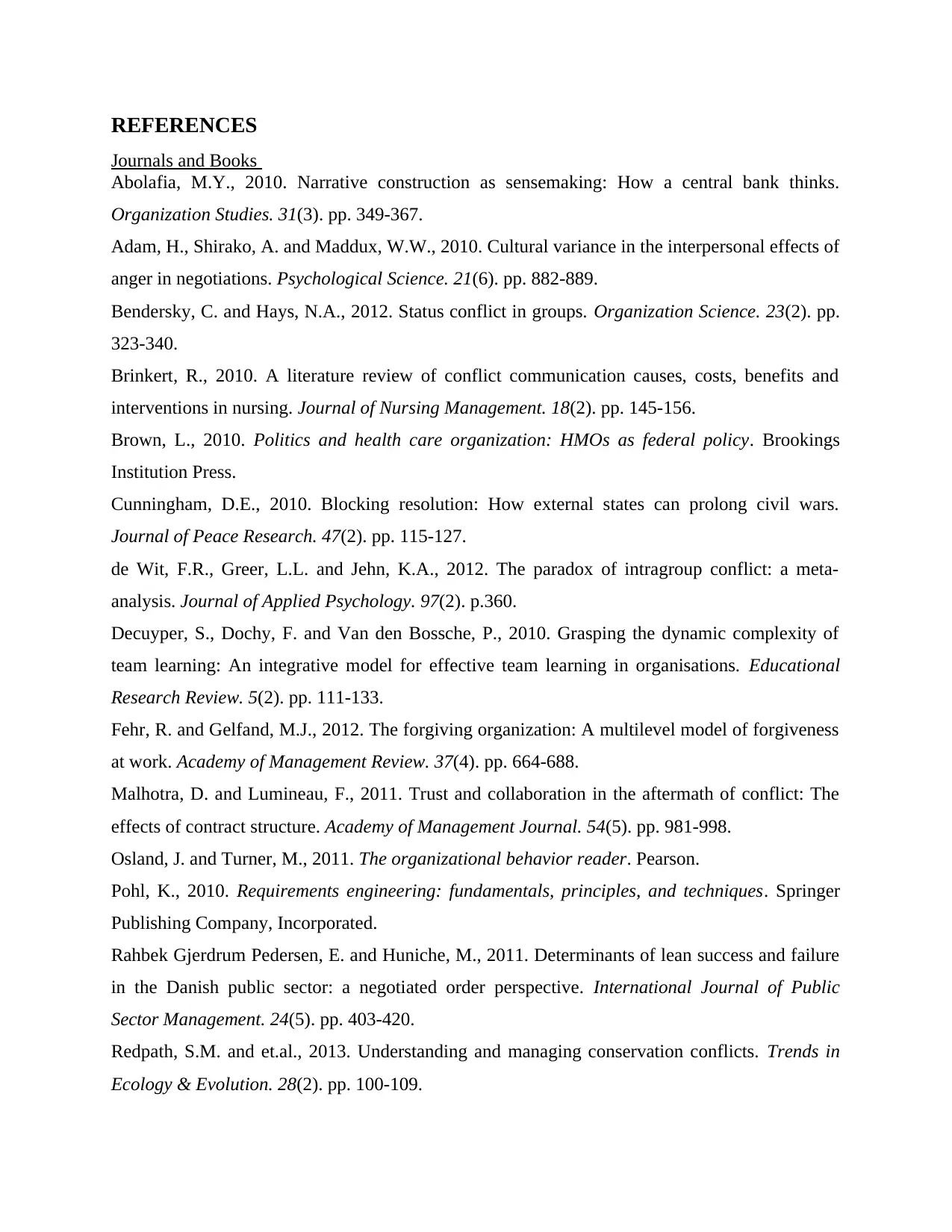
REFERENCES
Journals and Books
Abolafia, M.Y., 2010. Narrative construction as sensemaking: How a central bank thinks.
Organization Studies. 31(3). pp. 349-367.
Adam, H., Shirako, A. and Maddux, W.W., 2010. Cultural variance in the interpersonal effects of
anger in negotiations. Psychological Science. 21(6). pp. 882-889.
Bendersky, C. and Hays, N.A., 2012. Status conflict in groups. Organization Science. 23(2). pp.
323-340.
Brinkert, R., 2010. A literature review of conflict communication causes, costs, benefits and
interventions in nursing. Journal of Nursing Management. 18(2). pp. 145-156.
Brown, L., 2010. Politics and health care organization: HMOs as federal policy. Brookings
Institution Press.
Cunningham, D.E., 2010. Blocking resolution: How external states can prolong civil wars.
Journal of Peace Research. 47(2). pp. 115-127.
de Wit, F.R., Greer, L.L. and Jehn, K.A., 2012. The paradox of intragroup conflict: a meta-
analysis. Journal of Applied Psychology. 97(2). p.360.
Decuyper, S., Dochy, F. and Van den Bossche, P., 2010. Grasping the dynamic complexity of
team learning: An integrative model for effective team learning in organisations. Educational
Research Review. 5(2). pp. 111-133.
Fehr, R. and Gelfand, M.J., 2012. The forgiving organization: A multilevel model of forgiveness
at work. Academy of Management Review. 37(4). pp. 664-688.
Malhotra, D. and Lumineau, F., 2011. Trust and collaboration in the aftermath of conflict: The
effects of contract structure. Academy of Management Journal. 54(5). pp. 981-998.
Osland, J. and Turner, M., 2011. The organizational behavior reader. Pearson.
Pohl, K., 2010. Requirements engineering: fundamentals, principles, and techniques. Springer
Publishing Company, Incorporated.
Rahbek Gjerdrum Pedersen, E. and Huniche, M., 2011. Determinants of lean success and failure
in the Danish public sector: a negotiated order perspective. International Journal of Public
Sector Management. 24(5). pp. 403-420.
Redpath, S.M. and et.al., 2013. Understanding and managing conservation conflicts. Trends in
Ecology & Evolution. 28(2). pp. 100-109.
Journals and Books
Abolafia, M.Y., 2010. Narrative construction as sensemaking: How a central bank thinks.
Organization Studies. 31(3). pp. 349-367.
Adam, H., Shirako, A. and Maddux, W.W., 2010. Cultural variance in the interpersonal effects of
anger in negotiations. Psychological Science. 21(6). pp. 882-889.
Bendersky, C. and Hays, N.A., 2012. Status conflict in groups. Organization Science. 23(2). pp.
323-340.
Brinkert, R., 2010. A literature review of conflict communication causes, costs, benefits and
interventions in nursing. Journal of Nursing Management. 18(2). pp. 145-156.
Brown, L., 2010. Politics and health care organization: HMOs as federal policy. Brookings
Institution Press.
Cunningham, D.E., 2010. Blocking resolution: How external states can prolong civil wars.
Journal of Peace Research. 47(2). pp. 115-127.
de Wit, F.R., Greer, L.L. and Jehn, K.A., 2012. The paradox of intragroup conflict: a meta-
analysis. Journal of Applied Psychology. 97(2). p.360.
Decuyper, S., Dochy, F. and Van den Bossche, P., 2010. Grasping the dynamic complexity of
team learning: An integrative model for effective team learning in organisations. Educational
Research Review. 5(2). pp. 111-133.
Fehr, R. and Gelfand, M.J., 2012. The forgiving organization: A multilevel model of forgiveness
at work. Academy of Management Review. 37(4). pp. 664-688.
Malhotra, D. and Lumineau, F., 2011. Trust and collaboration in the aftermath of conflict: The
effects of contract structure. Academy of Management Journal. 54(5). pp. 981-998.
Osland, J. and Turner, M., 2011. The organizational behavior reader. Pearson.
Pohl, K., 2010. Requirements engineering: fundamentals, principles, and techniques. Springer
Publishing Company, Incorporated.
Rahbek Gjerdrum Pedersen, E. and Huniche, M., 2011. Determinants of lean success and failure
in the Danish public sector: a negotiated order perspective. International Journal of Public
Sector Management. 24(5). pp. 403-420.
Redpath, S.M. and et.al., 2013. Understanding and managing conservation conflicts. Trends in
Ecology & Evolution. 28(2). pp. 100-109.

Simmons, B.A. and Danner, A., 2010. Credible commitments and the international criminal
court. International Organization. 64(02). pp. 225-256.
Slaikeu, K.A. and Hasson, R.H., 2012. Controlling the costs of conflict: How to design a system
for your organization. John Wiley & Sons.
Themnér, L. and Wallensteen, P., 2014. Armed conflicts. 1946–2013. Journal of Peace
Research. 51(4). pp. 541-554.
Touraine, A., 2015. A method for studying social actors. Journal of world-systems research.
6(3). pp. 900-918.
Wallensteen, P., 2015. Understanding conflict resolution. Sage.
Watson, T., 2013. Management, organisation and employment strategy: New directions in theory
and practice. Routledge.
Zaccaro, S.J., Marks, M.A. and DeChurch, L. eds., 2012. Multiteam systems: An organization
form for dynamic and complex environments. Routledge.
Zeitoun, M., Mirumachi, N. and Warner, J., 2011. Transboundary water interaction II: The
influence of ‘soft’power. International Environmental Agreements: Politics, Law and
Economics. 11(2). pp. 159-178.
Online
Organisational Behaviour and Design: conflict and negotiation. 2016.[Online]. Available
through: <http://www.civilserviceindia.com/subject/Management/notes/organisational-
behaviourand-design-conflict-and-negotiation.html>. [Accessed on 25th July 2016].
What is Negotiation? 2016. [Online]. Available through:
<http://www.skillsyouneed.com/ips/negotiation.html>. [Accessed on 25th July 2016].
court. International Organization. 64(02). pp. 225-256.
Slaikeu, K.A. and Hasson, R.H., 2012. Controlling the costs of conflict: How to design a system
for your organization. John Wiley & Sons.
Themnér, L. and Wallensteen, P., 2014. Armed conflicts. 1946–2013. Journal of Peace
Research. 51(4). pp. 541-554.
Touraine, A., 2015. A method for studying social actors. Journal of world-systems research.
6(3). pp. 900-918.
Wallensteen, P., 2015. Understanding conflict resolution. Sage.
Watson, T., 2013. Management, organisation and employment strategy: New directions in theory
and practice. Routledge.
Zaccaro, S.J., Marks, M.A. and DeChurch, L. eds., 2012. Multiteam systems: An organization
form for dynamic and complex environments. Routledge.
Zeitoun, M., Mirumachi, N. and Warner, J., 2011. Transboundary water interaction II: The
influence of ‘soft’power. International Environmental Agreements: Politics, Law and
Economics. 11(2). pp. 159-178.
Online
Organisational Behaviour and Design: conflict and negotiation. 2016.[Online]. Available
through: <http://www.civilserviceindia.com/subject/Management/notes/organisational-
behaviourand-design-conflict-and-negotiation.html>. [Accessed on 25th July 2016].
What is Negotiation? 2016. [Online]. Available through:
<http://www.skillsyouneed.com/ips/negotiation.html>. [Accessed on 25th July 2016].
1 out of 13
Related Documents
Your All-in-One AI-Powered Toolkit for Academic Success.
+13062052269
info@desklib.com
Available 24*7 on WhatsApp / Email
![[object Object]](/_next/static/media/star-bottom.7253800d.svg)
Unlock your academic potential
© 2024 | Zucol Services PVT LTD | All rights reserved.





